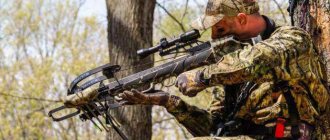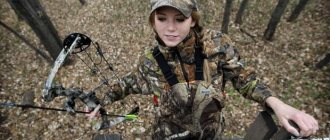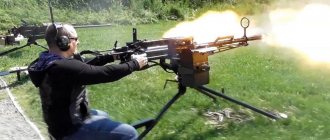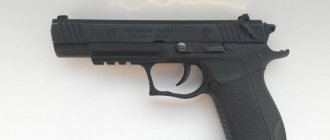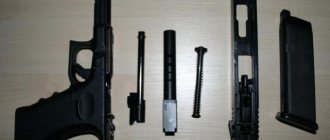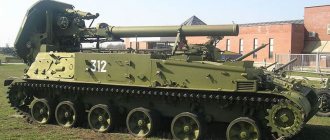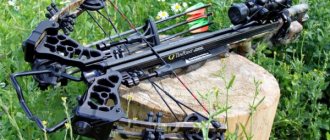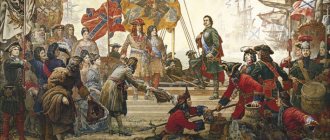Main characteristics
Pistol crossbows are loaded with darts, harpoons and balls.
Dart crossbows help develop marksmanship skills. They are lightweight and compact.
Crossbows with harpoons are more suitable for hunters and fishermen. They are characterized by accuracy and high firing speed. Such crossbows are made of heavy-duty materials and equipped with a steel bowstring.
https://youtu.be/zWlFASPc1-A
Arc - crossbow shoulders.
The shoulders of a crossbow, which are commonly called the arc, are one of its most interesting parts. The speed of the arrow in flight, as well as the accuracy and range of the shot, depend on them.
In a relaxed state, the arc looks with its shoulders forward, towards the opponent. Accordingly, in order to tighten the crossbow, you need to bend it in the opposite direction. To do this, they used a special machine that bent an arc.
The crossbow's shoulders, when relaxed, always face forward
Unlike bows, from which the string was removed immediately after shooting, the crossbow was always in a tense state.
The arches were made both from one type of wood and from a glued block. There are many known crossbows, the arcs of which were made of horns, tendons, and wood glued together.
Special glue was used to connect them. The English boiled the core of yew, tendons and horn membranes of cow horns in one cauldron, and in Rus' they preferred sturgeon glue.
Crossbow makers made weapons to suit every taste and budget. It was possible to order cheaper weapons from them, with arcs made of wood, horn and sinew, wrapped in birch bark or bast, and more expensive ones - in this case, the arcs were reinforced with plates of whalebone, and on top they were wrapped in finely dressed calfskin - parchment.
Interestingly, to obtain one kilogram of cow tendons, a whole herd was required - about 20 heads. Of course, the entire kilogram was not used to make one crossbow, but nevertheless...
Crossbow maker in his workshop. Engraving from H. Schopper’s book “Mechanical Arts” (1568)
The compound arches of hand crossbows usually reached a length of 700-800 mm; they were either wound to the stock with hemp ropes through a special hole in it, or fastened with metal staples.
The end of the Middle Ages was marked by the appearance of a steel arc in crossbows, which made them even more powerful than before.
Advantages and disadvantages
The advantages of crossbow pistols are undeniable:
- convenience and ease of use;
- compactness, making it easier to transport and carry weapons;
- versatility - can be loaded with various types of arrows.
Unfortunately, there are also disadvantages. This is primarily low power compared to other types of crossbow weapons. Such crossbows can only shoot over short distances. You can only hunt small animals with their help.
Varieties
All pistol crossbows can be divided into two types:
- block;
- recursive.
The recurve crossbow has been known since ancient times and is considered a classic version of self-propelled weapons.
Block is a more complex variety. There are blocks on his shoulders, and a bowstring is laid through them.
If we compare both types, the recursive one has the following advantages:
- a light weight;
- ease of learning;
- there is no need to adjust shooting accuracy;
- If the bowstring breaks, it can be easily replaced without stopping the hunting process.
Block models have the following advantages:
- high degree of maneuverability;
- long service life of the trigger mechanism;
- easier to pull by hand;
- higher boom speed.
Both types of weapons have their advantages. To decide which is the best and most powerful pistol crossbow, it is worth trying both of them in action. Both block and recursive types have gained their fans around the world.
General description and design features
Pistol crossbows are a type of this type of weapon that are used for shooting:
- dart;
- balloons;
- harpoons.
Products that are loaded with darts are mainly used for crossbow shooting training and entertainment. The remaining varieties are suitable for hunting small game.
The difference between classic crossbows and pistol-type models lies in the design features. The second version of the weapon is distinguished by a non-standard charging method. Like pistols, these crossbows have balls and darts inserted into a separate mechanism. Thanks to this, the weapon can be single- or multi-shot.
The distinctive characteristics of pistol-type models include the following:
- lightweight design (you can shoot while holding it with one hand);
- length - no more than 50 centimeters;
- special shortened arrows are used;
- compact sizes.
At the same time, due to the design features, this weapon is characterized by lower power and target range.
The most powerful pistol-type crossbow: a review of popular models
Each crossbow model is designed to achieve specific goals. To choose the most powerful pistol-type crossbow, you need to familiarize yourself with the most popular weapon models.
They all differ:
- speed of arrow departure;
- tension force;
- weight of the product.
MK-80 (plastic). A pistol crossbow that fires two-feathered arrows. There is an automatic fuse. Easy to cock. Composite material is used to make the shoulders, and a strong polymer thread is used for the bowstring. Designed for lovers of an exciting holiday. The initial speed of the arrows is 48 m/s. Weighs 0.6 kg. The force when tensioning the arcs is 36 kgf.
"Aspid". A powerful and at the same time elegant crossbow-pistol, one of the top sellers. Multifunctional, designed for shooting arrows and balls. Equipped with a fuse for safety. Not suitable for hunting, designed for sports and recreational shooting. Tension - 36 kgf. Weighs 1 kg.
MK-80A3. One of the most powerful pistol crossbows. Made of light metal alloy, weighs 0.8 kg. The design has an automatic safety and stirrup cocking. Supplied with aluminum darts. Arrow speed 48 m/s. Tension - 36 kgf.
"Scout" (aka "Behemoth"). For those looking for the most powerful pistol-type crossbow, the Scout is perfect. This weapon is of the highest quality. It was produced by Poe Lang, which produces many other popular models. Its main difference from other modifications is the presence of original grip and body linings, which allow you to confidently hold the weapon in both hands. The model is equipped with a scope rail. Arrow speed - 50 m/s. Weapon weight - 0.85 kg. Tension - 36kgs.
"Tactician". Often recommended as the most powerful pistol crossbow for hunting made in Russia. Available in different modifications. When shooting with balls, it is possible to achieve high results when hunting birds and game. It is distinguished by its low price and ease of care.
MISSION MXB 400
A crossbow with virtually no flaws! The MXB 400 is simply packed with innovative solutions and modern technologies.
| There are no offers for the sale of these crossbows on the used market - once you buy a MISSION of the MXB series, you will never sell it! |
Why are such speeds needed, since hunting with a crossbow is not supposed to be further than 50 meters? Let's say more, most often it varies between 5-25 meters.
It all depends on the object of hunting that you are going to hunt. If it is a healthy boar, then the weight of the bolt must be increased to ensure penetration on both sides. In this case, it is desirable to preserve the ballistics of the flight of a crossbow arrow.
That's all!
At working distances the difference between 330 fps and 400 fps will be insignificant. But powerful crossbows require more tension and fire louder.
There is one big problem with all powerful crossbows:
pressing in the plastic shank of the arrow and cutting off the bowstring with its tube, which leads to a blank shot and failure of the crossbow. That's why MISSION produces bolts with aluminum shanks for its crossbows.
| From the experience of many years of crossbow hunting and competitions, we can safely say: crossbows with a speed of 350-360 f/sec are the golden mean, which will provide you with comfortable operating conditions coupled with power sufficient for use on any hunting object. |
© 2016 All rights reserved.
Any copying of site materials is only with the permission of the administration of the site dendra.ru Share:
What does the price depend on?
When choosing a weapon, many do not understand the existing price range.
The price of a crossbow pistol is determined by:
- brand;
- materials;
- design;
- comfort of use.
Chinese models are inexpensive. But they are also made of unreliable plastic. Soon after the start of use, the bowstring may break. The bolts will fly far. In general, it is unlikely that a shooting enthusiast will enjoy using this type of weapon.
When buying a crossbow pistol, you should focus on:
- weight;
- tension force;
- size;
- shoulder and body material.
If you need high-precision shooting, you need a body made of durable but lightweight materials, and the bowstring must be made of the highest quality thread materials.
Is it possible to make it yourself?
Shooting enthusiasts often wonder: is it possible to create the most powerful pistol-type crossbow with your own hands? Of course you can. The main thing is to find drawings on specialized sites.
Crossbow arms are made of wood, fiberglass or metal. The stock requires high precision in processing and manufacturing; the arrow will be inserted into it. The trigger mechanism must respond exactly when needed. These are the main points to keep in mind when making your own weapons.
Modern crossbows: A crossbow for everyone!
Instead of a preface,
the purpose of this article is to help people interested in crossbow topics get involved in an interesting and exciting activity - shooting from this type of weapon.
It may well be that after reading it, another enthusiastic supporter of throwing weapons will become more . Perhaps this hobby will develop into something more and a crossbow shooter will someday become a hunter... Hunting with the help of this type of weapon is something special, than hunting with a firearm! The ability to shoot alone will not be enough here: determination, endurance, cold calculation, resistance to external irritating factors (weather, insects, body secretions...), the ability to remain invisible for a long time, wait for the moment and make the only right decision, take care of yourself... here the few things a real hunter should be able to do!
A crossbow is a specific weapon. It is quite silent, but not always and not for all types of animals (an alert elk, for example, manages to hear and react in time to a shot). Reloading takes quite a long time, so the hunter often only has one shot. A careless shot can lead to injury: for example, a wounded cleaver will rush at his offender, but there may not be a tree at the right time and in the right place... You should also not forget about careful handling of weapons. In general, despite the difficulties, overcoming them turns out to be interesting!
Nowadays, hunting is becoming the only opportunity for a man to acquire weapon skills. But every man is, first of all, a defender: of himself, his family, his country... The only bad thing is that the state does not understand this.
I will try (as much as I can) to be objective in presenting the material, despite its diversity and quantity.
Contents
Milestones Return of the crossbow Classification of crossbows Crossbow design
- Stock and guide
- Bow (shoulders) and mounting block
- Trigger
- Sighting devices
- Tension devices
- Bowstring
- Arrows and bolts
- Additional crossbow accessories (accessories)
Arrangement of a home shooting range Arrow catchers and their types Safety precautions
Development milestones
Shooting from any weapon has always been popular.
For a long time, people have strived for self-display by participating in various tournaments and competitions. The history of the use of throwing weapons for this purpose dates back to ancient times. In our time, the revival of competitions in archery and crossbow shooting is explained by the great emotionality of this shooting. CROSSBOW (French arbalete, from Latin arcus - bow and ballista - throwing projectile), crossbow, throwing weapon in the form of a powerful bow mounted on a wooden stock (machine), which allows for more accurate shooting, fundamentally different from a bow in the method of aiming .
It is difficult, of course, after so many centuries, to tell with any accuracy about the place of invention of the crossbow and the reasons preceding it... It is believed that the Chinese first created this device (at least, the remains of the crossbow discovered in burials near the city of Changsha date back to approximately IV -III centuries BC).
Chinese crossbow shooter
On the other hand, the Greeks can also no less successfully be considered the inventors of these weapons: in the works of Diodorus, the author of a forty-volume work called “The Historical Library,” the use of throwing machines in the defense of the city of Syracuse from the Carthaginians around 400 BC is mentioned. e.
Greek gastrofet
The crossbow was borrowed by Europeans from the eastern peoples during the Crusades, and only in the 12th century did it become widespread, especially in England and France...
Over the centuries, throwing weapons found their wide use on the battlefields of medieval Europe: from their fairly compact, portable counterparts to huge siege engines that required several people to operate them.
Medieval crossbow
With the advent of the crossbow, any person, possessing only elementary shooting skills, could compete in accuracy with a professional archer, and surpass him in the damaging effect of an arrow (so, according to some sources, a bolt at a distance of 150 meters hit a man-at-arms, and could knock a rider off his horse at a distance 200 meters). From that moment on, archers ceased to be a separate, highly paid caste, and they were seriously supplanted by the rapidly growing squads of crossbowmen. Due to its availability, the crossbow was considered a “low” weapon for a long time, unworthy of a noble knight.
The Second Lateran Council in 1139 banned the use of crossbows against Christians as a lethal weapon and allowed them to be used exclusively against infidels. But already around 1190, crossbows were used in the troops of Richard I of England and Philip Augustus of France, as a result of which Pope Innocent III revived the ban of the Council, which, however, did not produce any particular results. The townspeople gladly used crossbows in battles with knighthood; guilds of crossbowmen were created in German and Dutch cities under the patronage of St. Sebastian, St. Moritz and others. The commander of the crossbowmen in France received the title "Grand Master of the Crossbowmen" and was later equated with the marshals of the French kingdom.
In Rus', crossbows were called crossbows. It is believed that crossbows first appeared in Rus' in 991. y Novgorodians.
Unlike Western Europe, in Rus' in the 12th-15th centuries (the period of greatest use of crossbows), the role of infantry was less significant. The backbone of the Russian army was cavalry. Russian cavalry has always been distinguished by mobility and maneuverability and preferred light weapons for long-range combat - bows.
Crossbows in Rus' were mainly used in serf and siege warfare. It should be noted that when defending city fortresses, crossbows were most often used by townspeople rather than professional warriors, which was also typical for Western Europe.
Return of the crossbow
Tactical crossbow
TAC-15 Modern crossbows are difficult to compare with ancient ones. Of course, their appearance is somewhat different from medieval samples, and they do not have that gigantic power. According to various sources, ancient crossbows had monstrous strength in their shoulders; their forged arrows pierced through a horse in iron armor.
Of course, modern crossbows are limited in power, as required by law (no more than 43 kgf in Russia), they are not intended for combat, with the exception of those crossbows used by special forces. And people who buy crossbows do not want to have a “battering gun” from the time of the Hundred Years’ War at home.
Modern crossbows are characterized by the fact that the stock is made of a synthetic composite material or laminate, and the shoulders are made of composite or fiberglass. This crossbow is equipped with a trigger mechanism with a low trigger force; various types of sights can be installed on the crossbow; in addition, it can be supplemented with a variety of cocking devices. It is noteworthy that there is no mention of eccentric blocks in this list. This is because compound crossbows should not be considered more modern weapons than recurve crossbows. Although most crossbow manufacturers today prefer to produce compound crossbows, recurve crossbow technology has undergone a parallel evolution, and there are now very effective recurve crossbows on the market.
Over the past 20 years, crossbow manufacturing technology has made much greater progress than in the previous 2 millennia. Modern materials and components have made the crossbow a more convenient and more effective hunting weapon than crossbows built centuries or even decades ago. During the 1950s, most crossbows were boringly the same: almost all had a wooden stock that resembled a gun and steel shoulders. Some departure from tradition began when such and Barnett began producing crossbows with an all-metal stock.
Classification of crossbows
There are a large number of types of modern crossbows and it is quite difficult to classify them...
If we look at the size, then mainly rifle-type crossbows and pistol crossbows are produced.
As for the purpose, the following types are available:
- Sports. Diopter sights, the use of classic bows (however, there are block models) and more careful design of the stock; as for the arrows, they are lighter and shorter than hunting ones;
- A la Relic Working copies of ancient crossbows.
- Amateur. Inexpensive class of crossbows;
- Homemade. In some ways, this class can be considered a subtype of the previous one, but there are many exceptions;
- Hunting. They are distinguished by a large tension force, long and thick bolts, and are usually equipped with a compound bow;
The only parameter that is truly characteristic only of modern crossbows is the design of the bow (it itself is made of metal or plastic):
- Compound
- Classic (Recurve)
By type of projectile thrown:
- Classic, they shoot with a shortened arrow - the so-called “bolt”
- Balestres (as they were called in Italy) or schnappers (as they were called in Germany) - shoot a ball or small stone. Used when hunting waterfowl, upland game, or in any other conditions where it is difficult to find arrows after misses.
Sports classification, in this case the classification is carried out according to the type of bolts used and the bow tension force, block structures are not considered:
- Field - ~40 kg
- Match - 80-120 kg
At the same time, field crossbows shoot arrows, and match crossbows shoot torpedo-shaped bolts.
Strength (power) of the crossbow
In general, the strength of a crossbow is usually measured in terms of the tension of the bowstring. Hunting crossbows can have any power - usually over 43 kg. Not everyone can pull such shoulders, so various auxiliary devices (“attachments”) in the form of cranks, winches, and hooks are often used.
The power of a crossbow theoretically depends on two parameters:
- the force that the arc develops at the extreme point of the bowstring's stroke;
- the ultimate ability of the arc to bend or the stroke of the bowstring.
That is, energy (power) is equal to the product of force and distance.
In Russia, the tension force of leisure crossbows is limited by law to 43 kg. This does not prevent crossbow owners from purchasing and installing more powerful arms. Of course, in the case of an “upgrade” of a crossbow, its owner is breaking the law, and he will solve problems with law enforcement agencies on his own, depending on the situation...
Crossbow design
Structurally, the crossbow consists of the following parts:
- Stock and guide
- Bow (shoulders) and mounting block
- Trigger
- Sighting devices
- Tension devices
- Bowstring
- Arrows and bolts
- Additional crossbow accessories (accessories)
Stock and guide of the crossbow Varan
Stock:
During the evolution of crossbows, their stock has undergone major changes. The main materials for making stocks are now either natural wood materials: beech, walnut, yaranga, rosewood, or plastics. Of course, wood is preferable as a material. Wood looks better due to its natural beauty, and plastic is more practical and is not afraid of atmospheric influences. The wooden stock is simply pleasant to hold in your hands.
The stocks of most modern crossbows have an anatomical lightweight shape, which not only provides the necessary ergonomic parameters, but also gives it a modern look. Sometimes the shape of the stock is specially made in exact accordance with ancient samples and bears artistic carvings or inlays. Such authenticity gives crossbows a romantic character, reminiscent of the dark Middle Ages. Most often, working copies of antique crossbows are purchased as an expensive and very original gift.
Guide:
The guide in modern crossbows is very different from their ancient counterparts. If in ancient models, the guide was a regular groove cut out on the upper surface of the stock, then in modern crossbows the guide, in most cases, is made of a different material (metal, fiberglass) and is attached to the top of the stock as a separate part. Sometimes it consists of four or more rounded metal slats along which the arrow moves as if on rails. This system ensures high wear resistance of the structure and shooting accuracy. Fiberglass laminate is also an excellent material for making a guide. It is stronger than aluminum and at the same time practically does not wear out.
Shoulders of a polysplay system (block) with a mounting block from Barnett “Quat 400”
Shoulders:
Bows or, more correctly, the shoulders of modern crossbows come in two types: a block (or pulley) system and recurve ones. The shoulders are made from a wide variety of materials: steel, aluminum, fiberglass laminate, composite materials, carbon. The best-proven shoulders are made of composite, which is a multilayer structure of fiberglass and carbon. The fiberglass structure of the shoulders gives them high energy intensity, and carbon fiber has reinforcing properties. The shape of the shoulders, depending on the purpose, can be either straight or recursive, that is, with a characteristic bow-shaped bend. At their ends, crossbow arms have so-called “tips” - seats for the bowstring. The big advantage of the latest generation of shoulders is their “fatigue resistance” - the shoulders will retain the stability of their characteristics even after several thousand shots.
Shoe
:
The block is the piece that connects the arms to the crossbow stock. In modern models, the block is made of steel, aluminum alloys (to lighten the structure) or composites. The block (or cross) is cast, milled or obtained by stamping. It can also be made from wood. Its presence allows you to easily disassemble and transport the crossbow, have one stock and several interchangeable arms, with different tension forces to it.
Trigger mechanism of Ten Point crossbows
Trigger mechanism:
Locks, or triggers of modern crossbows are made using precision equipment from high-strength metal - most often it is weapon steel. Such locks can withstand enormous loads and are practically resistant to wear. The designs of the locks themselves differ from different manufacturers - from simple, elementary ones, similar in design to medieval walnut-type locks, to complex sports ones, with adjustable release force. Expensive match crossbows often use electronic release locks that are triggered by a light touch of a finger.
Optical sight Excalibur Vari-Zone 2-4x32
Sighting devices:
The main feature of sighting devices is determined by the ballistics of the flight of a projectile (arrow, bolt), which causes a significant change in the position of the aiming line relative to the line of departure (throwing angle) with a slight change in the distance to the target. Modern crossbows differ from their early predecessors not only in the use of the latest achievements in the field of materials science and design developments, but also in the use of original sighting devices. Existing sighting devices can be divided into two large classes: mechanical (diopter) and optical (telescopic, collimator, laser).
For hunting crossbows, there are special optical crossbow sights, with a characteristic sighting reticle (such as a mil-dot), which allows you to target the crossbow at different distances. In the class of sporting crossbows, standard sighting devices from sporting rifles are usually used.
Tension devices:
The design of the crossbow has been improved over many centuries. Over the years, the crossbow became an increasingly powerful weapon. And finally, the effort required to cock a combat crossbow exceeded the effort with which a person could draw a crossbow by hand. For this reason, special cocking devices - gates and levers - began to be introduced into the design of crossbows. They helped the crossbowman cock his weapon with minimal effort.
Of course, crossbow shooters have to constantly face the same problems in our time: the tension force of many modern sporting and hunting crossbows has already reached 90 kgf, and therefore their developers are forced to offer their customers a variety of mechanical cocking devices. Therefore, before you decide to purchase a powerful crossbow, it is worth thinking about how you will cock it, and whether you will need an additional device for this.
There are three main ways to cock a modern crossbow:
- It can be cocked by hand;
- By cable
- Using a special cocking mechanism - tensioner.
Each method has its own advantages and disadvantages.
Here's some food for thought...
Method No. 1 – manually cocking the crossbow:
The easiest and fastest way to cock a crossbow is to place your foot in the stirrup, bend over, and pull the string with your hands in the direction of the latch. Of course, this is easier said than done, especially if we are talking about a crossbow with a draw weight of 70 kgf or more. To cock a crossbow in this way, you must be able to lift that same 70 kg of weight from the ground. Manual cocking is an effective method, but it is clearly not suitable for everyone.
However, manually cocking a crossbow has one significant drawback. In order for a crossbow to shoot with sufficient accuracy, it is necessary that its string be pulled extremely carefully, that is, that the center of the string falls exactly on the trigger latch. If the crossbow is not tensioned evenly, the center of the string will move to the left or right side of the trigger mechanism, and as a result, the arrow will move to the left or right of the target after being fired. Some crossbowmen mark the center of the bowstring with white paint, making a small mark. This helps them understand how accurately the crossbow string is drawn.
Manual tensioner (cable)
Method No. 2 - cocking using a cable:
It is somewhat easier than manually to cock a crossbow using a cable. During this procedure, a simple block system is used, which allows you to reduce the tension force by 50%. Instead of hauling a 150 lbs (68 kg) load, you will have to work with a 75 lbs (34 kg) load, but the distance it will have to be moved will double. Crossbow draw cables typically have two handles (similar to the handles on a lawn mower's recoil starter), two brackets that hold the string, and a cable that connects everything together. To cock a crossbow, you need to place the tensioner brackets on the bowstring and pull its handles up. The leg, as in the previous case, should rest against the stirrup. This method also requires sufficient physical strength, but still, cocking a crossbow using a tensioner cable is much easier than manually.
The main advantage of such a tensioner is that it allows you to cock the crossbow using only half the force required to fully cock it. Thus, most people can independently cock a crossbow with a draw weight of 150 lbs (68 kg). In addition, usually cocking a crossbow using such a tensioner helps improve the accuracy of its combat, since the tensioner itself centers the bowstring at the moment of full tension.
Crankaroo Mechanical Tensioner for Excalibur Crossbows
Method #3 - Mechanical Tensioners:
A mechanical tensioner is a small hand-held crank usually installed in the butt of a crossbow. It allows you to cock the crossbow by rotating the tensioner handle. Some models of mechanical tensioners are designed so that they can be attached to the crossbow, while others are built-in mechanisms. A mechanical tensioner typically requires only about 10 lbs of force to rotate the handle, so these tensioners allow just about anyone to cock a powerful crossbow with ease. This device is especially popular among hunters and amateur shooters who have various physical disabilities.
Bowstring
:
The bowstrings of modern crossbows are made primarily from two types of materials: Kevlar thread, known to everyone from body armor, and fast flute thread.
The bowstrings are wound from these super strong threads and are additionally reinforced with winding on top. A modern bowstring is several times thinner than an ancient one, but is capable of withstanding powerful shock loads and is designed for several hundred shots. Arrows:
Their durability, accuracy and firing range, and injury safety for the shooter and others depend on the quality of the arrows. Arrows are made from duralumin, carbon, aluminum tubes, fiberglass and wood. The most famous manufacturer of quality arrows is Easton.
Approximate parameters of arrows for crossbows:
- Length: 300 – 400 mm
- Diameter: 6 – 9 mm
- Number of feathers: 3 or 4 pcs.
- Pen length: 50 – 70 mm
- Pen height: 10 – 12 mm
- Arrow weight: 15 – 40 grams
The boom set must meet the following requirements:
- all arrows must be the same length and thickness;
- have identical weight and plumage;
- have the same rigidity (boom deflection under load);
- have the same distance between the center of gravity and the middle of the boom;
- the boom rod (tube) should have minimal deformation when bending.
Boom tail (straight)
Currently, three types of fletching stickers are used on arrows: straight, angular and helical (spiral) of 3 or 4 fletchings.
The arrangement of the feathers can be as follows:
The smaller the diameter of the shaft, the length of the arrow, and the thickness of the tail, the less external forces (wind gusts) will influence, the aerodynamic drag will decrease, and the flight range will increase.
Arrows with sporting tips
Tips for hunting
Additional crossbow accessories (accessories):
Additional crossbow accessories include: cases, bags and cases for storage and carrying; straps that allow you to carry a crossbow; arrow quivers; thread for winding the bowstring; accessories for reducing noise when fired; stringer (device for tensioning the bowstring for a recurve crossbow); shako and wax for the bowstring.
Shako for hunting crossbows Escalibur
Shako:
- a device that firmly holds arrows with hunting tips. Attached to the crossbow using a quick-release mount.
Wax for bowstring
To protect the bowstring from moisture, lightly rub it with beeswax. The wax should be rubbed in carefully so that the string threads do not break or become deformed. It must be remembered that lubricant increases the weight of the bowstring and leads to a decrease in the speed of the arrow, so it should be lubricated with a small amount of wax.
Setting up a home shooting range
If you are a city dweller, or even a resident of a big city, then the question of where to find a place to quietly shoot becomes a serious problem. Even in the largest cities of Russia, the number of shooting ranges suitable for archery and crossbow shooting can be counted on the fingers of one hand. This means that almost every owner of a bow or crossbow must spend at least an hour on the road to the shooting range, and then the same amount of time on the way home. Considering that interest in archery and crossbow shooting in our country is constantly growing, and there are no more shooting ranges, one day you risk finding yourself in a crowded shooting range and finding out that there simply isn’t enough lane for you!
Shooting from any weapon is potentially traumatic for others, so any reasonable person understands that going out into the courtyard of an apartment building in the evening and shooting is out of the question! The risk of an arrow injuring or even killing a person or animal is too great. You should not attempt to shoot in parks and city recreation areas. The sound of projectile weapons, such as bows and crossbows, is often loud enough to spook game, but it is much less than the sound of a firearm and will not warn of danger to a person or domestic dog who might suddenly emerge from the bushes and trees.
For the owner of his own home or cottage, there is a simple way out of this situation. You can set up a shooting range in your yard. If you can allocate a shooting lane 10-15 m long and 1-1.5 m wide, consider it half done, because everything else can be purchased at the store.
So, what does the owner of a future home shooting range need?
- First of all, of course, he will need a bow or crossbow. If your goal is to learn to shoot accurately and at the same time spend as little money as possible, you should buy an inexpensive crossbow. You can choose inexpensive Korean crossbows MK-150, MK-200 or the Scorpion crossbow. If you are willing to pay a lot of money for a crossbow, take a closer look at the Cayman crossbow.
- In any shooting range you cannot do without a target. Believe me, shooting at a wooden fence or tree will end up ruining your arrows. Even if you buy the cheapest arrows over and over again, such shooting will still cost you a pretty penny. The most reasonable solution is to purchase an amateur shield made of isolon (foam rubber). Such a shield lasts quite a long time, does not damage arrows, weighs little and, if necessary, can be easily moved to another place. The size of such shields is 50x50 or 85x85 cm. A large shield, of course, is more reliable and more convenient, but the choice, in this case, is yours. The shield can be hung on a tree, but it is better to install it on a wooden tripod. It is not always available for sale in specialized stores, but it is easy to make yourself. The thickness of the shields also varies. If you only shoot with a bow, you can buy a shield 18 cm thick, but if you plan to shoot with a crossbow, then it is better to take a thicker shield - 28-40 cm wide.
- To make everything “grown-up” and you can accurately evaluate the results of your shooting, we recommend purchasing paper targets. They are inexpensive and it is better to take several pieces at once, because arrows quickly render them unusable.
- You will also need arrows with practice tips. To begin with, it is better to buy 10 arrows for a crossbow.
- In no case should we forget about shooting safety. Therefore, a special arrow-catching mesh should be installed behind the shield. This is not difficult to do; the net is hung on stakes. Such a net will guarantee that the arrow will not hit a person or animal. Another benefit of such a device is that it will not be difficult to find an arrow that has flown past the shield and got stuck in the net, but finding it in thick grass is always a difficult task.
Arrow catchers and their types
The uniqueness of throwing weapons over firearms is that a crossbow arrow can be used for shooting over and over again, unlike disposable powder charges. However, this uniqueness will come to naught if you shoot at anything and do not use special devices for this, called arrow catchers. When an arrow hits an arrow catcher, it smoothly transfers its energy to the shield, without experiencing fatal loads aimed at its destruction.
Arrow catchers come in the following types:
- from sheets of unpressed fiberboard:
The shield is assembled from sheets of unpressed fiberboard (12 mm thick). This fiberboard is very soft and therefore not traumatic for any arrows. However, it easily holds back even crossbow bolts from a 150-pound crossbow.Shield dimensions - 1200x1000 mm. The fiberboard sheet can be 1800x1200 mm in size, we cut it into 6 parts 300x1200 mm. One panel requires 17 sheets of fiberboard. Estimated price - 900-1000 rubles for 1 shield (17 sheets). We lay the sawn sheets in a “book” between two thick boards (60-70-80 mm) 2 meters long, after which we fasten them with two metal ties on the thread (top and bottom). if there is a wall nearby, then we lean the resulting shield against it at a slight angle, and if there is no wall, then we will have to attach a couple of supports at the back so that the shield does not fall. It weighs a lot, so this option is best suited for a stationary shooting range. When an arrow hits such a shield, it produces a very pleasant sound.

- from reed:
Several large armfuls of reed are cut, after which they are tied as tightly as possible with strong ropes in several places. By “reed” I mean any of the available marsh plants, be it reeds, cattails, etc., which grow almost everywhere.The reed needs to be dry. Therefore, it makes sense to take care of its supplies in advance. By the way, in winter it is just dry, and besides, preparing it while walking on ice is much easier than in summer. The sheaf can be pulled together by slipping a stick under the rope, and the rope can be twisted with this stick as a lever. The resulting “sheaf” is cut evenly on one side. The diameter of the sheaf is made depending on the shooting distance and the skill of the archer. The better you are at shooting, the smaller the diameter of the sheaf you need, and the less reed you need. But it’s better not to skimp on reeds and make the arrow receiver as large in diameter as possible (up to 1-1.2 m). You can draw multi-colored target circles at the end of the arrow receiver or simply hang a regular archery target of a suitable size.
The reed arrow receiver is installed on the stand, as shown in the figure. The stand can easily be made from several boards. Please note that the top boards of the stand have a semi-circular cutout so that the sheaf of reeds does not move. Such an arrow receiver turns out to be very inexpensive. But at the same time, it perfectly performs its function and confidently holds almost any arrow, even with a sharp forged hunting tip. As the reed wears and chips, you can tighten the ropes even tighter, and the arrow receiver will serve you for some time. After this, you can simply replace some of the reed with a new one.
- from carpet:
A powerful arrow catcher that can be made from ordinary carpet. The scheme is the same - a roll secured with tape. Not heavy, holds arrows convincingly. From 30 meters, out of 270lb, it goes up to 70 percent... from 50 meters - to the tail. They are much easier to extract than from isolon.Its disadvantage is that to remove the arrow, it is often necessary to unwind the roll back...
- from tow:
A good arrow catcher can be made from tow. It is sold in flat rolls 50 cm in diameter and 20 cm in depth. They are called "Washers". It is used for insulating houses made of logs or bars.The arrow does not penetrate deeply, the tow does not jam, the “wound” heals... That is. we have an almost indestructible arrow catcher...
- from isolon:
You can make an arrow catcher from isolon. Izolon is a material with a wide range of applications. It is used as heat, sound, hydro and vapor barrier. Details on its production can be read here. One of the unpleasant features of such a shield is that it is difficult to pull an arrow out of it.
In principle, you can buy a ready-made arrow catcher. However, given its cost, almost no one does this.
Safety precautions
ATTENTION!
When handling a crossbow,
YOU MUST FOLLOW SAFETY PRECAUTIONS!!!
- Shooting can only be carried out in specially designated and equipped areas with a fence.
- The site is limited by security zones on the sides of at least 10 m, behind the shields 25 m.
- Shooting at different distances must be done from one common shooting line.
- Before shooting, carefully check the weapon to ensure that the cables and string are intact and that all parts are securely attached.
- Do not pick up or carry bows and crossbows by the string.
- You can insert an arrow only when the target area and the space in front of them is clear.
- It is allowed to point a crossbow with a loaded arrow only from the shooting line and in the direction of the target.
- It is forbidden to talk or turn to the side while the crossbow is cocked and the arrow is inserted. It is not recommended to call out or touch the shooter while aiming at the target.
- It is not recommended to shoot in the air, upward.
- The shooter is responsible for any incident that occurs as a result of his violation of safety rules.
While shooting from a crossbow, it is prohibited
- Place your fingers in the area of movement of the bowstring
(your fingers will be torn off). - Shoot the crossbow empty
(the arc will break, causing damage to both the shooter and others). - Use arrows that are too light for shooting
(quick loss of their arc. Consequences, see point 2). - Make sure that there are no people or animals in front of the target when you shoot. It is better to lock animals in the house.
- Do not allow children to shoot a bow or crossbow without an adult present.
- Do not leave the crossbow in a tense state for a long time.
- Move with a cocked or loaded crossbow.
Is it dangerous to shoot with a crossbow?
Weapons must be respected and safety precautions observed. There were two cases: one person was shooting from a stand in a tree, and was holding the crossbow too close to the tree trunk. The straightened shoulder hit the tree and threw the shooter from his perch, he fell and hurt himself. The second case - a man wanted to test the power of a crossbow, for which he shot at the kinescope of an old Soviet TV, the arrow pierced it right through, and a piece of glass flew back and severely injured the crossbowman’s face.
In general, crossbow shooting is a completely safe sport or active recreation 
Warfare - Crossbow
Materials used from the following sources: https://www.arbalest.ru https://www.znaikak.ru https://www.maximus-arbalet.ru https://www.balista.ru
Good luck and all the best!
Seeker
